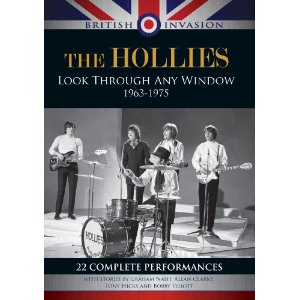
 In 2010 the first four discs in a DVD series entitled British Invasion were released to great acclaim. That first release featured discs focused on the Small Faces, Dusty Springfield, Herman’s Hermits, and Gerry & the Pacemakers that could be purchased separately, or as a set which included a bonus disc.
In 2010 the first four discs in a DVD series entitled British Invasion were released to great acclaim. That first release featured discs focused on the Small Faces, Dusty Springfield, Herman’s Hermits, and Gerry & the Pacemakers that could be purchased separately, or as a set which included a bonus disc.
The hallmarks of the series were classic, often live performances from European television appearances and concerts, blended with contemporary interviews with the artists. The audio and video was newly remastered, so everything looked, and sounded great. There were also new essays from respected music writers like Rob Bowman. The bonus features for this embarrassment of riches often included even more performance footage.
The newest entry in the British Invasion series is The Hollies: Look Through Any Window 1963-1975, and like its predecessors it is the definitive chronicle on its subject. There is no commentary on these discs. The story is told bythe interviews with the artists, and by the music which is arranged chronologically to accompany the story. The detailed liner notes are by the legendary Ben Fong-Torres.
What we tend to forget is just how many great songs, many of them hits, these artists had. For example, on the Hollies disc, there are 22 performances, nearly all of them songs that we remember. The highlights, and there are many, include hits like “Look Through Any Window,” “Bus Stop,” “On A Carousel,” and “He Ain’t Heavy, He’s My Brother.” There are also songs that may be less remembered, but are no less memorable. These include “Wings,” “I Can’t Let Go,” and the banjo-driven “Do the Best You Can.”
The story of the Hollies is told by childhood friends Allan Clarke and Graham Nash who founded the band, along with guitarist Tony Hicks and drummer Bobby Elliott who joined early on. We learn of their beginnings in Manchester, their love for the music of the Everly Brothers, and the shaping of their sound which included the all-important distinctive three part harmonies that emerged with the arrival of Hicks.
After having one hit after another, Nash got restless and wanted to move the band in a new direction. The band followed him, but the street was a dead end commercially. Suddenly instead of top ten hits, they only made the top 30 with more adventurous fare like “King Midas In Reverse.” The band was angry about the failure, and soon returned to their traditional pop sound with “Jennifer Eccles,” a song which Clarke and Nash admit was rather innocuous, but had the desired effect.
Nash was still looking for something new. During a stay in Los Angeles he met David Crosby and Stephen Stills, and the rest is rock history. Nash left the Hollies in December, 1968, and he was replaced by Terry Sylvester.
Everyone thought the Hollies were done when Nash left, but they made a stirring comeback with “He Ain’t Heavy,” which they followed with another smash, “Long Cool Woman,” before closing out their career with “The Air That I Breathe.”
The Hollies will never be spoken of in the same breath as the Beatles or the Rolling Stones, but they created a lot of great music in their time. Look Through Any Window brings that music back for an encore, and it is a welcome bow indeed.
[kml_flashembed movie="http://www.youtube.com/v/7tpIcUwG5l4" width="600" height="344" allowfullscreen="true" fvars="fs=1" /]





Comments